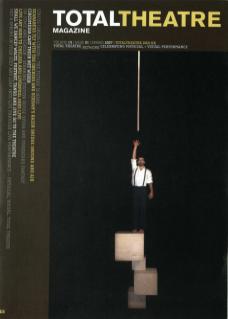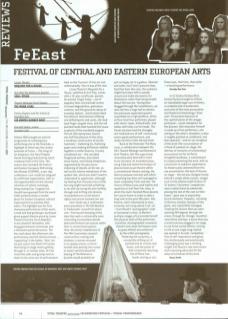FeEast 2006 brought an eclectic programme of contemporary performing arts to the Riverside, a highlight of which was the London premiere of Sclavi – The Song of an Emigrant, the Total Theatre Award winning production by Czech company Farm in the Cave. The season also included the Central and Eastern European Performing Arts Market (CEEPAM), a two-day conference-cum-trade fair plagued by inefficient organisation, with no real opportunities for the claimed intention of artistic exchange, being instead (as I suppose we should have guessed from the event title) predominantly a market place for Eastern European cultural organisations to promote their wares. The highlight was the first showcase performance of the event, a mad and bad grotesque-burlesque glove puppet theatre piece by Lissen Theatre from the Czech Republic. It was downhill thereafter, with long gaps between showcases and a lacklustre panel discussion. The less said about the afternoon solo performance and the technical team ‘supporting’ it the better, I feel. Let me just say to Ines Worth of Croatia that being on stage means getting through it, no matter what. At first I took the sulks and grumps and restarts to be some sort of performative take on the ‘liveness’ of live art, but unfortunately I fear it was all for real.
Lissen Theatre’s Requiem for a House, subtitled An Evil Play, comes with a 15-plus certificate: parents be warned, forget Sooty – use of puppetry does not preclude scenes of sexual degradation, gratuitous violence, and the gruesome abuse of everyday objects. I particularly liked the balloons that became inflating and deflating tits and cocks, the madeyed finger-puppet mice, and the red painted hands that haunted the house as ghosts of the murdered puppets. The set (the eponymous house) was half the pleasure of the show, a wondrous construction of tactile materials – clattering tin, fluttering paper and creaking driftwood cobbled together in artful disarray. A lovely soundtrack too – the recorded fairground waltzes, discordant music boxes, and ticking timepieces, augmented by the percussive clattering of objects on the set, as well as the intense melodrama of the spoken text, which you didn’t need to understand to appreciate, although my feeling that the piece was a little too long might have had something to do with my losing the plot halfway through and drifting into dreamy incomprehension as the bizarre sights and sounds washed over me.
Soul-Etude was a multimedia piece presented in The Old Abattoir in Clerkenwell. A word first about site: I find myself wearying of the idea that work is intrinsically more interesting if presented outside dedicated theatre/art spaces rather than in conventional spaces. Here, the lovely installations of Petr Nikl (automata carousel constructions casting wild shadows; a woman encased in an opaque piano; a mirrorheaded man peering into a pool of water) and the beautiful playing of The Balanescu Quartet would probably be just as happy set in a gallery. (Warmer and safer, too!) And I presume that, had that been the case, the audience might have been left to wander around and make discoveries for themselves rather than being herded about like tourists. Having been dragged through the installations, we were led into a large hall to witness the previously separated quartet assembled on a high platform, whilst at floor level four performers played with elastic ropes, billiard balls, and tables with holes cut for heads. This finale set piece had the strangely old-fashioned air of self-consciously avant-garde performance, and made me feel a little old and tired.
Back at the Riverside: The Mona Lisas, a collaboration between the UK’s Theatre Melange and Romania’s Ariel Theatre, felt like a genuinely innovative work that didn’t need to try too hard. An ensemble piece, using tried and tested techniques of physical and visual theatre within a conventional theatre setting, the distinct purpose and skill with which everything was done still managed to seem completely fresh and new. The chorus of Mona Lisas used rhythm and repetition to tell their/her story, in which the multi-faceted Mona deserts her Louvre frame in order to take a long look at the past 500 years. War, famine, man’s inhumanity to man, certainly, but rising above it all, art – from Manet’s ‘pornographic’ nude to Duchamp’s urinal, to Warhol’s multiple images of La Joconde herself. The physical skills of the performers (carefully choreographed movement theatre and clown techniques used to great effect) are enhanced by the artful scenography: fluttering silk costumes, a constantly shifting set of painted and lit screens and boxes, and the power of that constantly returning line of Mona Lisa masks staring us out. Those eyes, that face, that smile – a haunting performance.
Dorothy Max Prior
In Sir Vantes Donkey Khot, Dmitry Krymov brought to FeEast an improbably large cast of eleven, a complete lack of pretension, and some of the most provocative and theatrical dramaturgy I have seen. Provocative because of the sophistication of the images portrayed – visual metaphors for the Quixotic (the character himself is made up of two performers, one sitting on the other’s shoulders; a door is roughly painted on cardboard, and then opened) – and for our reception of the work (the accumulation of a flood of sawdust on stage, the detritus of centuries of scholarship); provocative too for its fierce straightforwardness, a commitment to simply presenting the work, with no concession to audience expectation. Its theatricality stemmed from this raw presentation: the lack of illusion on stage – the set was changed noisily behind a simple white curtain, images such as the relative small stature of Sir Vantes’/Cervantes’ compatriots were crudely drawn by awkwardly placing the rest of the cast on their knees – gave way to exquisitely lyrical moments. Puppetry, including a hilarious shadow-autopsy of the giant, was masterfully managed, creating the illusion that you were spinning 360 degrees through the scene, through his ribcage. Invention came thick and fast: a horse that was a wired suitcase plugged in on stage to cue horse sound effects, coming to life as one single long-lashed eye opened in its side. Completely free of self-importance and gloss, this intellectually and emotionally challenging piece was a thrilling insight into Russia’s new work sector and a stunning advocate for the value of a festival of this kind.
Beccy Smith

